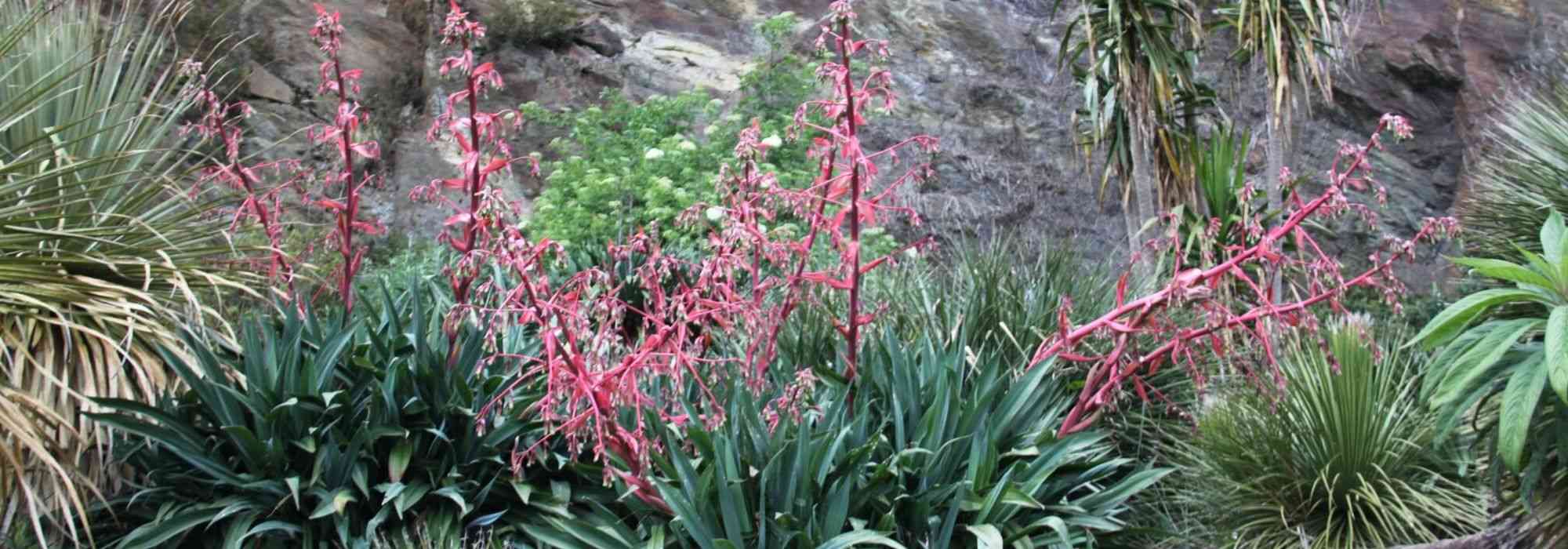
Beschorneria: planting and care
Contents
Beschorneria in a nutshell
- Beschorneria is a succulent perennial plant with an exotic appearance
- Like a Yucca but without spines, it forms impressive rosettes of architectural blue-green leaves
- In summer, its flowering of red and green bell-shaped flowers on a 2 m tall flowering stem is spectacular
- Semi-hardy, a perennial for mild climates, ideal in Mediterranean and Atlantic regions
- Perfect in a dry garden for adding structure to large borders and exotic rockeries
A word from our expert
Beschorneria or Mexican Lily is a succulent, exotic perennial plant closely related to agaves and Yucca.
Whether hardy like Beschorneria septentrionalis or more tender like Beschorneria yuccoides with relatively lower hardiness, it tolerates mild winters fairly well and will thrive in a dry garden in mild climate or in Mediterranean areas.
With its ribbon-like leaves gathered into large rosettes, its architectural silhouette and its spectacular flowering on tall coral‑red spikes that can reach 1.50 m to 1.80 m, it brings a very exotic touch to gardens spared by severe frost or to a well‑exposed terrace elsewhere. It stands out even in winter! Beschorneria albiflora is the only member of the genus to form a small trunk and bear pale pink flowers.
All enjoy full sun in any well‑drained soil, even poor, stony soil.
To create an exotic atmosphere, choose your Beschorneria from our selection, and grow it in the ground or in a pot according to your region!
Description and botany
Botanical data
- Latin name Beschorneria
- Family Agavaceae
- Common name Mexican lily, false yucca, false agave
- Flowering May to August
- Height 1.10 to 2 m
- Exposure Sun, partial shade
- Soil type poor, free-draining
- Hardiness -8 to -15°C depending on species
Beschorneria or Mexican lily, sometimes also called “false yucca” or “false agave”, is a fleshy herbaceous perennial plant of the family Agavaceae, like Agave and Yucca, native to open oak and pine woodlands and rocky slopes up to 3,500 m altitude in semi-desert to occasionally humid areas of Mexico.
Genus Beschorneria includes ten perennial species well suited to our temperate climates that are not too cold. Beschorneria yuccoides, or superb Beschorneria, the most widespread, hardy down to -8/-10°C, is frequently found in Breton or Mediterranean gardens. Less well known, Beschorneria septentrionalis is certainly the hardiest species in the genus (down to -15 °C in perfectly drained soil).
Rather slow-growing but long-lived, Beschorneria can take 5 to 10 years to reach full ripeness but thickens up over the years thanks to its rootstock capable of producing numerous offshoots around the initial rosette, ensuring longevity: these small peripheral rosettes will flower in later years, thus ensuring progeny. It can become invasive where it thrives.
Plant forms a rosette of basal leaves, 50 cm to over 2 m tall in flower and 1 to 1.5 m across depending on species. Only Beschorneria albiflora forms a small trunk.
This large rosette is made up of large evergreen strap-shaped leaves, 90 to 120 cm long and about 10 cm wide, resting directly on the soil and imbricate with each other.
Sword-shaped, they are lanceolate but not spiny at the tip unlike those of yuccas, slightly canaliculate, flexible, arching outwards. They are usually soft, more rarely slightly rough. Succulent and pruinose, they display a very beautiful bright green or silvery blue-green colour. The Beschorneria yuccoides ‘Quicksilver’ has foliage more silvery than the species. In some cultivars, leaves are variegated with cream.
From this very exotic clump of leaves emerges in summer, from May–June to August depending on sunlight and climatic conditions, an always impressive flowering. A single majestic terminal flowering stem, reaching 1.5 to 2 m in height, arises from the centre of each rosette. This spectacular flowering only occurs after 3 to 4 years of cultivation, as Beschorneria needs time to develop sufficiently to flower. Unlike most Agavaceae, plant is not semelparous and does not die after flowering.
Each large fleshy, serpentiform stem of red-pink colour stands upright then arches towards the ground to one side. It bears numerous tubular, pendulous flowers grouped in racemes. They resemble long little bells or tulips turned downwards. Corollas are composed of 3 petals of a striking bright apple-green washed with red at the base and 3 petaloid sepals, with surrounding red or pink bracts. Flowering is more delicate in Beschorneria septentrionalis than in Beschorneria yuccoides. As they open, bract colour intensifies to coral red, contrasting with the bright green and enhancing exotic appearance of the flowers. Beschorneria albiflora is notable for pinkish-white flowers.
These bicoloured little bells, gracefully inclined towards the ground and full of nectar, attract many insect pollinators.
Depending on species, flowers are then followed by fruits — dehiscent capsules — or by bulblets that can take root.
Contrary to popular belief, beneath this exotic appearance, Beschorneria is hardier than commonly thought and perfectly suited to temperate climates that are not too cold. In colder regions, it is grown in large pots and overwintered.
It thrives in sun or partial shade in warm climates, in ordinary fairly light soil, even stony and sandy, but crucially well-drained.
In climates that are not too harsh, it will structure a large exotic rockery, a dry bank, a Mediterranean planting, or the edge of a dry woodland. It is indispensable in a scree garden, in a dry garden as well as in Mediterranean-inspired gardens.
Read also
10 hardy plants for an exotic dry gardenMain species and varieties
Most popular
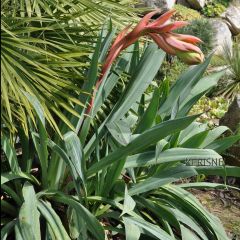
Beschorneria septentrionalis
- Flowering time July to September
- Height at maturity 60 cm
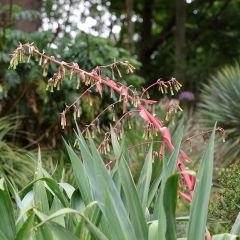
Beschorneria yuccoides
- Flowering time July to September
- Height at maturity 70 cm
Our favourites
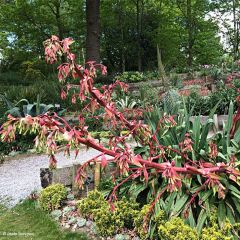
Beschorneria yuccoides Quicksilver
- Flowering time July to September
- Height at maturity 70 cm
Discover other Beschorneria
View all →Available in 1 sizes
Available in 1 sizes
Available in 1 sizes
Available in 1 sizes
Available in 1 sizes
Planting
Where to plant Beschorneria?
Le Beschorneria is a perennial not so frost-tender, which will nevertheless withstand frosts down to about -15°C (sometimes only to -7/-10°C for semi-hardy species) but only in very well-drained soil. In regions with harsh, overly wet winters, its hardiness is often severely tested. Prefer regions with mild winters and short frosts to grow it in open ground: it dislikes moisture, especially when combined with cold.
It therefore favours climates of Mediterranean regions or Breton coast. In mild climate, it tolerates sea spray very well and grows very well by the sea. In colder regions plant it in a very large pot on the terrace, to be put away for winter indoors or in an unheated greenhouse, protected from severe frosts.
It prefers sunny positions and will accept partial shade in warmest parts of country. From its Mexican origins it has retained good resistance to drought and high summer heat. It will grow easily in dry shade under trees, between tree roots.
Undemanding regarding soil type, it accepts almost any correctly drained soil. It prefers poor, sandy, dry, even stony and calcareous soils.
If ground retains too much moisture, plant it preferably on a steeply sloping bank which will drain naturally.
Allow sufficient space because after a few years it will reach large proportions. It forms suckers to fully occupy available space and can become invasive.
With its very graphic appearance, this succulent plant used as a specimen or in groups structures exotic scenes of large dry rockeries, arid banks and large gravel beds, to which it brings scale and relief. Without thorns, it can edge splendid paths. In pots, it gives an exotic touch to terraces and small urban gardens.
When to plant?
Plant in spring, ideally April to May, or in late summer, August to September.
How to plant?
Allow about 3 Beschorneria plants per m2. If soil is too heavy: add gravel, small stones or coarse sand to improve drainage because it dislikes winter wetness.
In open ground
- Dig a hole 2 to 3 times the pot’s volume
- Add a 10 cm layer of large stones or gravel to bottom of planting hole
- Plant Beschorneria without burying the collar too deeply
- Backfill with a mix of potting compost, river sand (50%) and ordinary soil
- Firm down lightly
- Mulch with a layer of small gravel or pumice to keep soil cool and release warmth at night
- Water copiously at planting then during dry periods
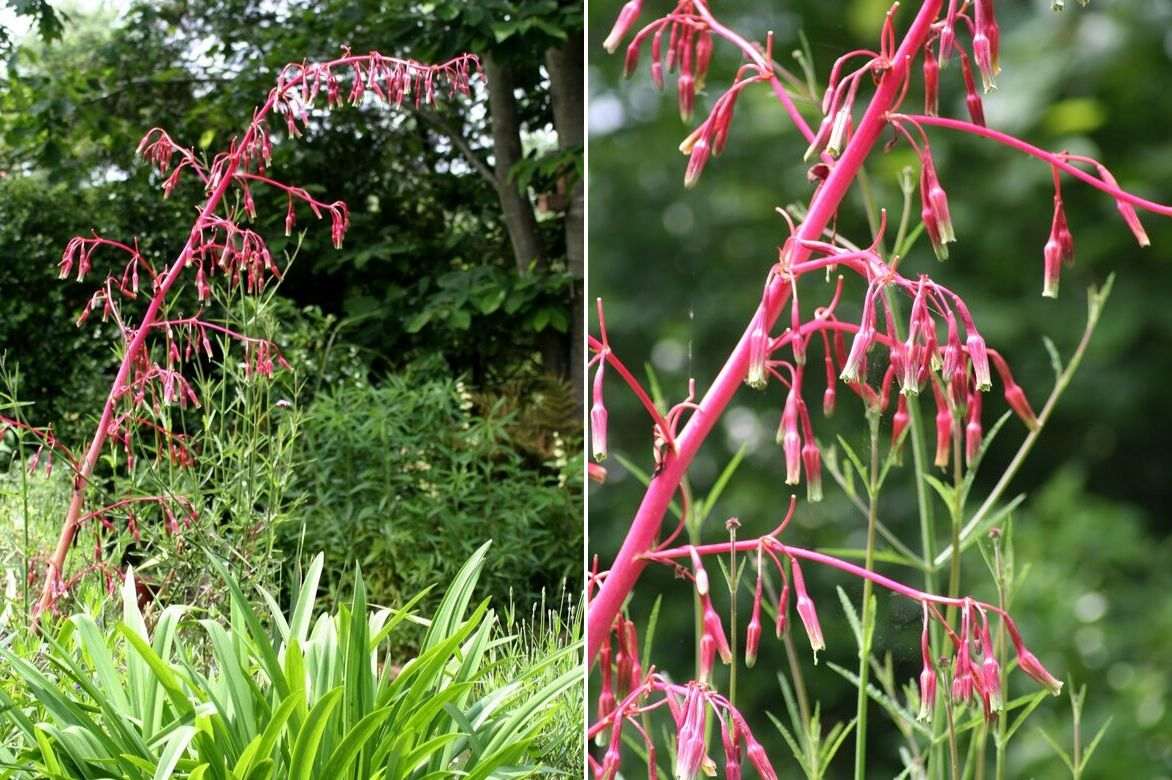
Beshorneria septentrionalis, likely the hardiest species in genus!
In pots
Beschorneria performs very well in pots and should be brought indoors for winter in cold, wet regions into a cool room. Substrate must be very free-draining to avoid root rot in case of excess water. Watch container size as plant develops quite large.
- In a very large terracotta pot of at least 60 cm diameter, spread a good layer of gravel, stones or clay pebbles
- Plant in a mixture of garden soil, coarse sand and potting compost for Mediterranean plants
- Mulch base with gravel or pebbles to prevent collar rot
- Water, then water regularly, allowing soil to dry out between waterings
Care and maintenance
Well suited to gardens and dry soils, the Beschorneria is a plant that requires little water but does appreciate occasional watering to keep leaves plump.
In summer, water about once every 15 days. Once well rooted in free-draining soil, it will only need watering during periods of severe drought.
In winter, stop watering.
In regions with harsh winters, protect plant from severe frosts with winter fleece.
Maintenance is limited to removing faded or dried flower stems and tidying old foliage at the end of winter: using a pruning shear or a shear, cut leaves that are blackened, damaged or withered right back. Beschorneria requires very little maintenance but can become invasive where it thrives: remove suckers after flowering if you wish to limit its spread.
In a pot
Bring pot inside before first frosts, keep in a cool room (between 0 and -5°C) and water sparingly once a month in winter. It will appreciate occasional light misting of its leaves.
Every 3 or 4 years, in spring, repot into a slightly larger container or top-dress, adding a layer of garden soil and potting compost to about one third of the pot depth.
As for diseases, Beschorneria is not troubled by much apart from winter damp and severe frosts.
→ Learn more with our advice sheet: Diseases and parasitic pests of Beschorneria and Growing a Beschorneria in a pot.
Multiplication
Sowing is possible in February–March, in a light, moist substrate kept warm at 21 °C. The Beschorneria naturally produces well-developed suckers around the main rosette that appear after flowering. They are very easy to detach to propagate by lifting young rosettes in spring. But be patient: they will take 3 to 4 years before flowering.
- Using a spade, gently lift the sucker
- With a pruning shear, separate it from the parent plant
- Replant directly into open ground or pot up in a light mix of gravel, garden soil and river sand
- Water
Pairing Beschorneria in the garden
Beschorneria is ideal perennial for exotic-inspired gardens, contemporary or Mediterranean, and for sun-baked dry gardens. With its shaggy silhouette and spectacular summer flowering, it helps structure rockeries and slopes or adds scale to a bed of low Mediterranean perennials and small bushes.
On a slope it can be paired with equally undemanding plants such as Agave americana, prickly pear (Opuntia ficus-indica), giant fennel, Cylindropuntia imbricata and Opuntia humifosa, two hardy cacti, and the blue leaves of Yucca rigida.

An example of a pairing on perfectly drained soil, in full sun and in a mild climate: Beschorneria yuccoides, Phormium tenax ‘Golden Ray’ (replace with Yucca ‘Bright Star’ or ‘Colour Guard’ in cold climates), Agave havardiana, Anigozanthos flavidus (Hesperaloe parviflora ‘Rubra’ or Crocosmias among the hardiest in cold climates), Senecio mandraliscae (Festuca ‘Intense Blue’ or Helictotrichon sempervirens to bring that bluish touch in cold climates) and Sedum spectabile ‘Brilliant’ (or ‘Septemberglut’)
In a bed of Mediterranean perennials, it will form an interesting focal point alongside Hesperaloe parviflora, Canary vipers’ bugloss, Aloe vera, Geranium maderense, cordylines or Acanthus sennii with thistle-like leaves.
In a more naturalistic scheme, its thornless leaves blend very well with other perennials that need no maintenance such as shrubby sages, an arborescent aloe, and dianthus.
At edge of a light woodland, it will grow easily alongside Acanthus mollis, Phlomis samia or Jerusalem sage.
It will stand out in mineral scenes surrounded by a few grasses such as Miscanthus or Stipa gigantea and by dry-ground groundcover plants such as dwarf artemisias, perennial purslane, thymes and sedums.
In cold, wet regions, plant in a very large pot on the terrace, right beside a Crassula sarcocaulis, a small banana or palms.
→ Discover other ideas to pair the Bershorneria in the garden on our advice sheet!
Useful resources
- How to create an exotic garden?
- Which exotic plants to pair with your Beschorneria?
- Our tutorial: How to propagate Beschorneria?
- Which plants are the most graphic to create a minimalist, uncluttered ambience?
- Discover our advice sheet to help choose the right Beschorneria.
- Subscribe!
- Contents
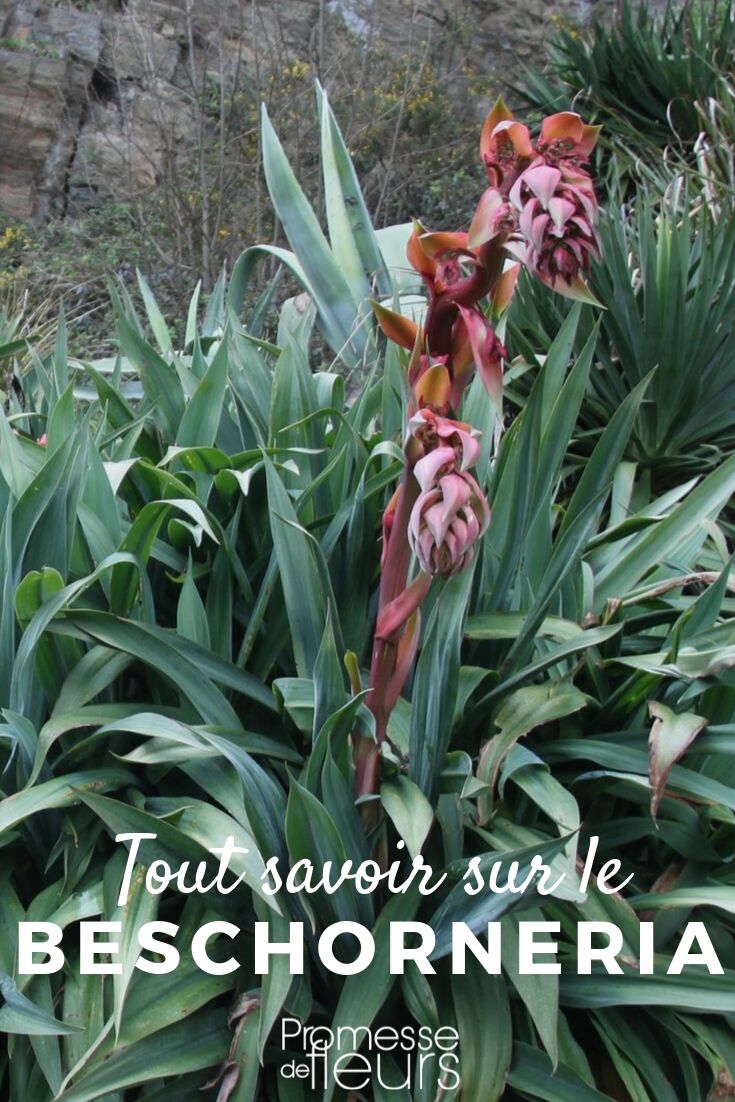































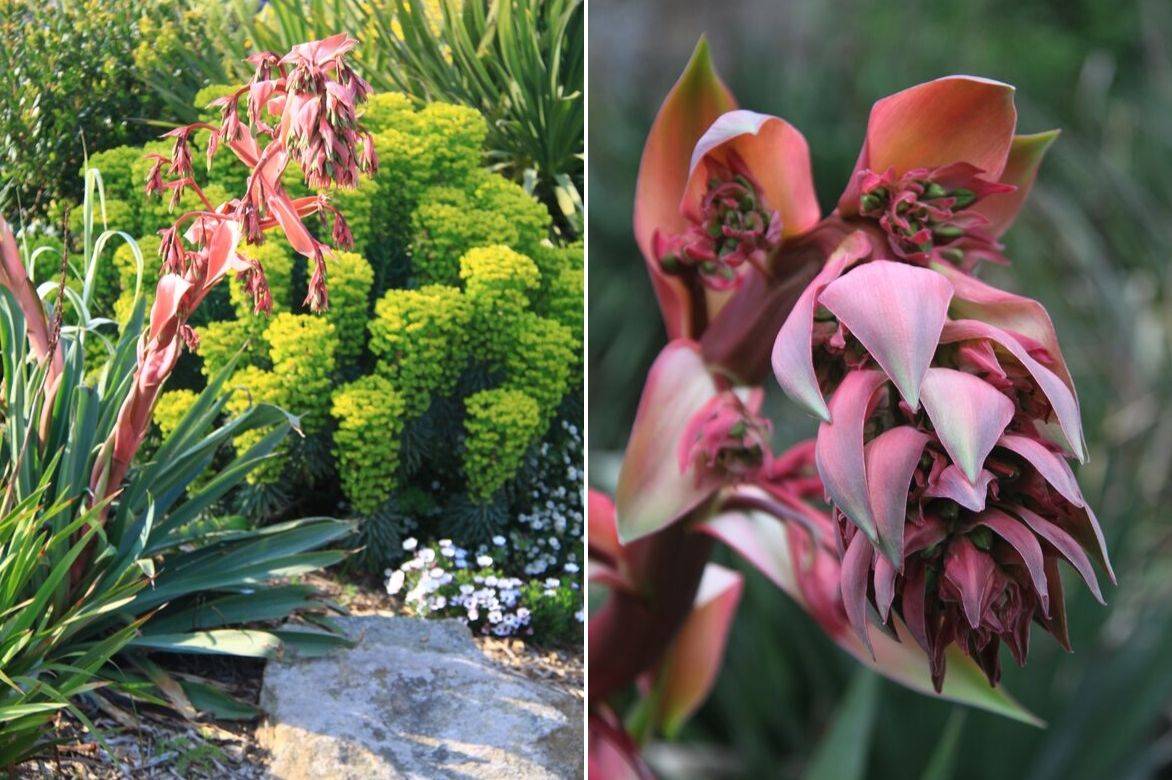
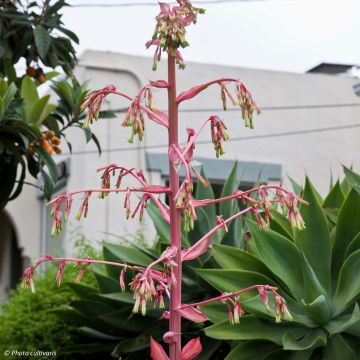


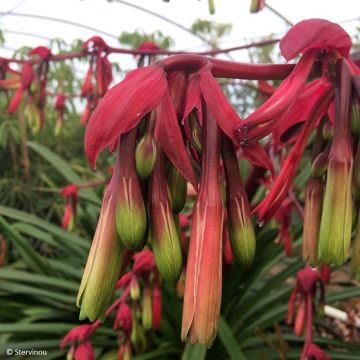

Comments